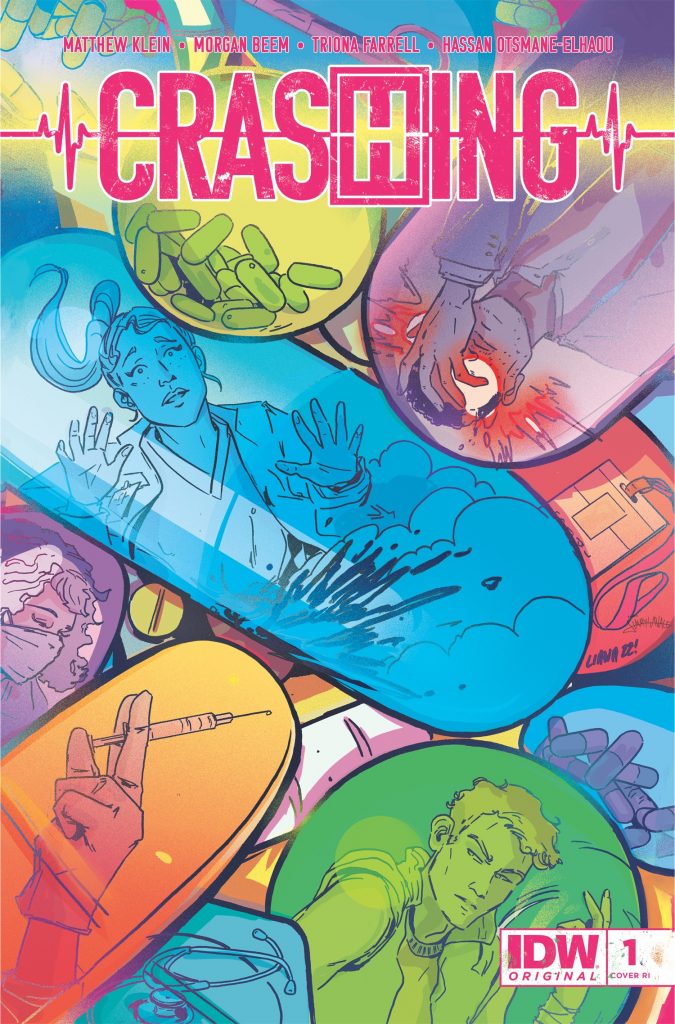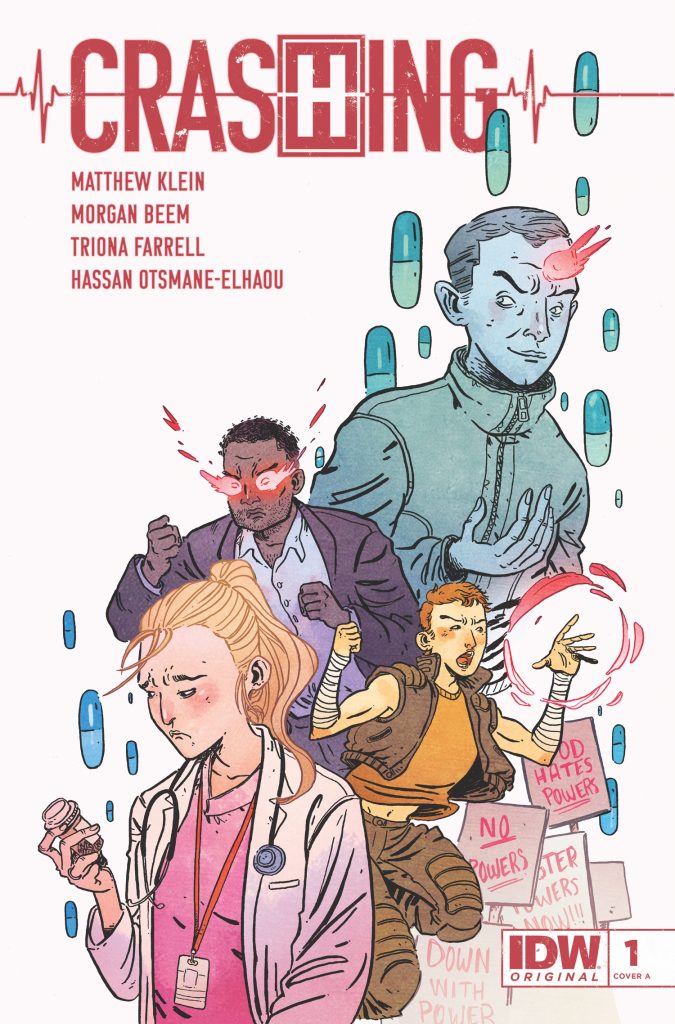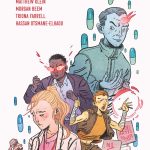Matthew Klein & Morgan Beem Talk “Crashing” – Interview

As someone who is looking forward to the debut of Crashing issue 1 this September, I got the chance to talk to writer Matthew Klein and illustrator Morgan Beem to learn more about what their five-part comic book will offer readers.
From IDW, Crashing has been described as The Boys meets Nurse Jackie. The story revolves around Rose Osler. Picking up less than ten years into her rehabilitation, recovering addict Rose is one of the few doctors in the US who specialize in treating “Powered individuals”.
I recently shared a sneak peek for issue 1.
Here’s my interview with the creative duo!
The Geekiary: I have to ask, where did the idea of having a non-powered human doctor be the lead in a world with superpowered beings come from? We don’t really have a bunch of stories being led by “human” doctors or healers in the superhero comic book space. Why decide to take such a route?
Matthew Klein: The inspiration came from seeing the stories of first responders, doctors, and nurses in the midst of the pandemic. Like everyone else, I was surrounded by first-hand accounts of their daily struggles to save lives under the most overwhelming circumstances.
Heroes are among us. They don’t have to shoot lasers from their eyes or wield a weather-controlling scepter. Instead, they maneuver scalpels and run down corridors in tennis shoes.
Our culture teaches us to treat doctors like superheroes. Except, they’re people, too. And throughout the pandemic we witnessed so many of them enduring this daily dose of trauma but still going to work every day. Doctors and nurses have their own villains that they fight and the whole team got really into the idea of tackling an everyday hero, surrounded by people with powers, who has the power to heal or destroy them and herself with her choices. Hence, Rose Osler was born.
TG: Without spoilers, what kind of character arc, the main narrative theme of said arc, can readers expect Rose to go through in the current five-issue story?
Klein: The incredibly smart marketing folks at IDW came up with this idea of a downward spiral in five issues and I think that’s pretty on point. In the first issue, Rose is put through the wringer and pushed to her breaking point. That breaking point is to where she may need to give up seven years of sobriety in order to survive the day and save her patients. Being put to that choice has deadly consequences for her, her marriage, her career, and the people she wants to help. It is Rose’s story of learning the importance of self-care, essentially. Learning the value of putting your own needs first and how that enables you to take care of others.
TG: What would you like for the readers to take away from a story like Crashing?
Klein: That asking for help doesn’t make you weak. In fact, it’s admirable. This is a story about a person who doesn’t believe she deserves help, never asks for it, rebukes every offer she gets, and has to handle the consequences of this self-destructive behavior. Learning how to recognize you need help and realizing that asking for help is okay would be the most rewarding sentiment a reader could tell me they take from Rose’s journey.
Morgan Beem: That people are complicated. And none of us are defined by our best or our worst moments. That no matter what, we have to keep going. That it’s okay to keep going, no matter what.
TG: One word each to describe Rose Osler?
Klein: Hero.
Beem: Hubris.
TG: If you could drop Rose in any other fictional comic book world, kind of like a crossover, where would she fit?
Klein: For me, it’d be Daredevil. I’d love a Rose/Karen Page team-up. Throw in Dakota North for good measure, who I think is a criminally underutilized character. But yeah, put Rose in the street-level grit and grime of the Marvel Universe and I’d be thrilled.
Beem: Hellblazer. I think not only would her skills be very useful there, where everyday and the supernatural meet, but I could see her and Constantine becoming begrudging besties.

TG: Any advice for creatives new to the comic book industry and getting ready to collaborate with a writer or artist they haven’t worked with before? Would you like to share, even if briefly, how the collaboration process works between you two?
Klein: My advice to writers out there is to simply write. I’ve talked to tons of people at Cons and visiting shops who all say, “I’m a writer.” The first thing I ask is, “What have you written? Is there anything I can read?” Write. And it can be bad. Like just terrible. In fact, it will be bad. And that’s great! That’s what it’s supposed to be at first.
My first drafts for every issue of Crashing are awful. Then, through working with a phenomenal editor, the scripts get better with every draft until they’re ready to put in Morgan’s hands. And then she makes them a million times better than I ever imagined. Each person on our team, from Morgan to colorist Triona Farrell and letterer Hassan Otsmane-Elahou, everyone picks up the baton in the relay of making this comic and brings such greater depth of storytelling that it’s awe-inspiring to see each issue’s final form.
As far as advice to writers working for artists for the first time, I’d say be very upfront about what you know and don’t know. Start from a place of honesty and communicate, even overcommunicate at first. You have to build trust and a rapport together. It takes time and you have to give it time. But you can’t do that unless you and your collaborators understand the story you’re telling first.
Beem: My advice would be to try not to be too rigid or attached to your way or how you initially envisioned things. A creative team is a team, it’s a collaborative process, so there will be both give and take. Trust that your teammates know what they are doing, even if it isn’t 100% how you envisioned it. Notes and feedback make the book stronger.
At the same time, make sure your team also has faith in your skills, and that you communicate well. If a project is like pulling teeth, it might not be a great fit and it is better to recognize that early on before everyone is miserable.
Also like Matthew said, communication is the most important! Over communicate-it will help the book!
So far the team for Crashing has been a dream to work with. Everyone is exceptionally good at what they’re doing and I think it really shows in the pages we are making!
TG: Thanks for your time. Where can we find you?
Klein: Thanks for asking! You can find me on Twitter at @macktheknife316 and on Instagram at @macktheknife1116. I post all about comics and pro wrestling and lots of food. That’s pretty much it for me, a ridiculously delicious meal while talking about Batman and watching WWE Smackdown and you, too, dear reader can come along for the ride!
Beem: You can find me on Twitter @morganbeem, my website morganbeemart.com, and bummin’ around Denver.
TG: Other than Crashing, is there anything else you would like our readers to check out?
Klein: Back in April I collaborated on a ten-part hardboiled detective webcomic called No Rhyme Or Reason with artist Rich Wojcicki and letters by Nick Philpott. It’s over on Tapas and is totally free. If you’re looking for a pulpy eighties noir it’s a ton of fun and each chapter is only eight-to-ten panels! You can check it out at: https://tapas.io/series/No-Rhyme-Or-Reason/info
Beem: If you like my work and are curious to see more, check out my other books Swamp Thing: Twin Branches from DC comics, and The Family Trade from Image!
–
Are you excited about reading Crashing issue 1?
Let us know.
Author: Farid-ul-Haq
Farid has a Double Masters in Psychology and Biotechnology as well as an M.Phil in Molecular Genetics. He is the author of numerous books including Missing in Somerville, and The Game Master of Somerville. He gives us insight into comics, books, TV shows, anime/manga, video games, and movies.
Help support independent journalism. Subscribe to our Patreon.
Copyright © The Geekiary
Do not copy our content in whole to other websites. If you are reading this anywhere besides TheGeekiary.com, it has been stolen.Read our






